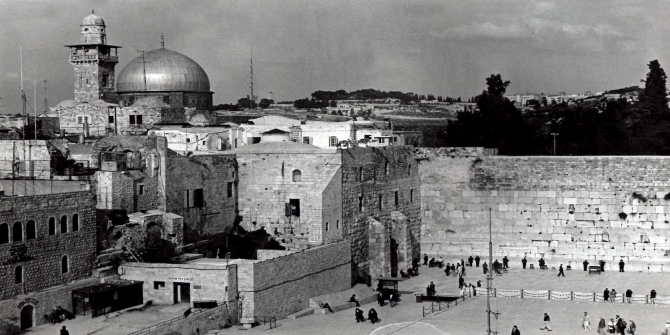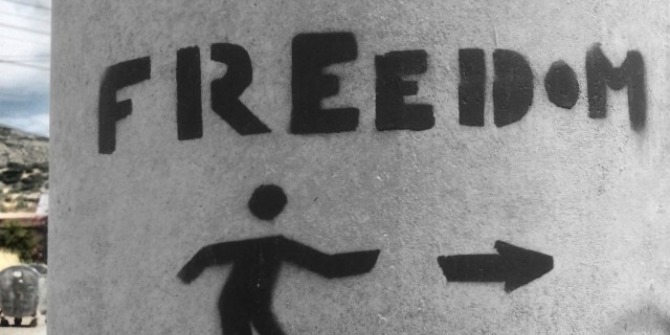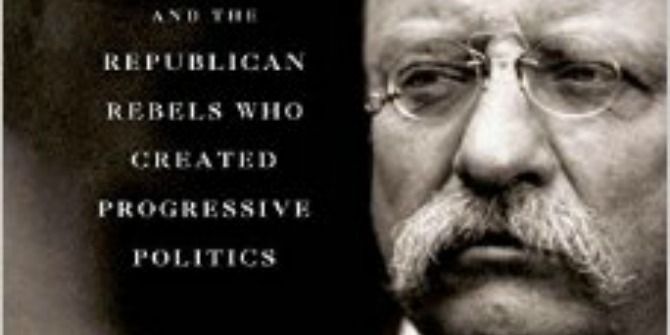In Enemies and Neighbours: Arabs and Jews in Palestine and Israel, 1917-2017, Ian Black offers a new panoramic history of the Israeli-Palestinian conflict, beginning with the Balfour Declaration in 1917 up until the present day. Linking the impact of political decisions to everyday lives and experiences and drawing on a wide array of voices and perspectives, this is a beautifully written and up-to-date introduction to the development of the conflict, finds Menachem Klein.
Enemies and Neighbours: Arabs and Jews in Palestine and Israel, 1917-2017. Ian Black. Allen Lane. 2017.
A century has passed since World War I, providing an opportunity to revisit one of the war’s most famous byproducts: the Balfour Declaration. In his letter to Lord Rothschild on 2 November 1917, Lord Balfour, then British Foreign Secretary, wrote:
His Majesty’s government view with favour the establishment in Palestine of a national home for the Jewish people, and will use their best endeavours to facilitate the achievement of this object, it being clearly understood that nothing shall be done which may prejudice the civil and religious rights of existing non-Jewish communities in Palestine, or the rights and political status enjoyed by Jews in any other country.
Just twenty years after its foundation, the Zionist Federation had scored a remarkable diplomatic coup. Great Britain, still then the most powerful colonial empire, recognised the young national movement as the sole representative of the Jewish people; integrated the Zionist political goal into its colonial policy and post-war plans; and relegated Palestine’s non-Jews, then 90 per cent of the population, to mere religious communities.
The short text, just 67 words, had a far-reaching impact. The League of Nations included it in the Mandate it gave to Britain in 1922. Without such an endorsement, it is unlikely the newly-formed United Nations in November 1947 would have accepted the plan to partition Palestine into separate Jewish and Arab states. The Balfour Declaration, therefore, frames the unsolved Israeli–Palestinian conflict and its impact continues to reverberate. Ian Black rightly sees this as Year Zero of the conflict, starting and ending the narrative of Enemies and Neighbours: Arabs & Jews in Palestine & Israel, 1917-2017 with the Declaration.
 Image Credit: Dome of the Rock and the Western Wall, Jerusalem, 1992 (Dun.can CC BY 2.0)
Image Credit: Dome of the Rock and the Western Wall, Jerusalem, 1992 (Dun.can CC BY 2.0)
It’s no surprise that Black’s book is clear and beautifully written, with his time as Middle East editor at the Guardian lasting over 35 years. Nevertheless, in writing a book that covers a century and combines many sources into one integrative narrative, the author moves from reporting on individual events to writing a fascinating panoramic history. Moreover, unlike other historians of the conflict that limit their study to political or ‘institutional’ history, Ian Black shows the impact political decisions and armed clashes had on average citizens’ lives and perceptions. Historians rarely make this linkage.
As noted, the book is an integrative study. Black does not uncover new archive documents or reveal unknown affairs. Rather, he takes the reader along a linear history of the conflict, moving chronologically through its main events. Each of the 26 chapters covers a few years in around twenty pages, and so the book is an excellent up-to-date introduction to the development of the conflict.
Black integrates into his chronological narrative voices and perspectives that readers would struggle to find outside specialist studies or the primary sources themselves. For instance, he discusses methods Israeli-Palestinians (that is, Palestinians that became Israeli citizens) used after the 1948 war to preserve their Palestinian identity and national narrative. At that time, in the 1950s and the 1960s, Israeli state agencies did their utmost to impose the Jewish-Israeli narrative on these communities, through closely monitoring the education system, imposing strict media censorship and subjecting them to martial law. After the 1967 war, the two parts of the Palestinian nation – those who lived within Israel’s ‘1948’ borders as Israeli citizens and their compatriots from the Jordanian West Bank and Egyptian Gaza Strip – met. The meeting empowered their common national identity.
Black’s general picture of one of the longest active national conflicts is gloomy. He ends his book observing that ‘violence was never far away’ in the annals of Israeli–Palestinian relations and he predicts no end to the conflict for the foreseeable future. Black’s narrative leads to the conclusion that from Balfour Declaration in 1917 until the Palestinian revolt in 1936, the conflict gradually developed, and since the 1936 revolt it has been repeating itself. For instance, take the words of the Israeli diplomat Walter Eytan in 1951:
The Arab states […] do not recognise Israel; consequently there is no one with whom to negotiate. Their whole attitude is based on the thesis that Israel has no right to exist. Israel has shown that she could ride out ten years of unrelenting enmity […] and she can live with it for decades and generations more if she must (163).
If you replace ‘the Arab states’ with ‘the Palestinians’, you get the present popular Israeli view and the mirror of Prime Minister Netanyahu’s typical statements, echoing nearly all of his predecessors.
Does the Balfour Declaration still shape the Israeli–Palestinian conflict? Whereas in the Balfour Declaration Great Britain supported the establishment of a national home for the Jewish people within Palestine, successive Israeli governments since 1977, with few short-lived exceptions (namely the administrations of Prime Ministers Olmert and Barak), claim sovereignty over all of it and restlessly agitate to de facto annex the entire land through settlement construction. Moreover, most Israelis do not base their claims of sovereignty over all Palestine on the Balfour Declaration and international recognition, but on God’s promise as documented in scripture. Political Islam, indeed, is the mirror image of this approach.
Thus, after 100 years, the intent of the original Balfour Declaration is fading away. The Israeli–Palestinian conflict in the twenty-first century is an ethno-religious conflict over all Palestine. Due to settlement expansion and Israeli control over the entire territory between Jordan and the Mediterranean, the Palestinian Authority has been subordinated. This is a new dimension for the old conflict between two separate national liberation movements, whereby it is now a domestic conflict – within the territory ruled by Israel – between two ethno-religious collectives almost demographically equal, but deeply divided and unequal in their civil rights.
- This review was originally published on the LSE Middle East Centre blog.
Please read our comments policy before commenting.
Note: This article gives the views of the authors, and not the position of USAPP– American Politics and Policy, nor of the London School of Economics.
Shortened URL for this post: http://bit.ly/2kg8B5l
——————————————–
About the reviewer
Menachem Klein – Bar Ilan University
Menachem Klein is Professor in the Department of Political Studies at Bar Ilan University and was a team member of the Geneva Initiative Negotiations in 2003. He is the author of The Shift: Israel-Palestine from Border Struggle to Ethnic Conflict and Lives in Common: Arabs and Jews in Jerusalem, Jaffa and Hebron.


 Find this book:
Find this book: 


